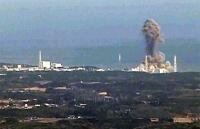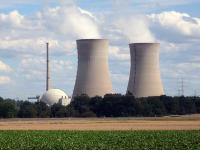-
Fukushima disaster was preventable: Study

The worst nuclear disaster since the 1986 Chernobyl meltdown never should have happened, according to a new study. Researchers distilled thousands of pages of government and industry reports and hundreds of news stories, focusing on the run-up to the Fukushima Daiichi disaster in 2011. They found that “arrogance and ignorance,” design flaws, regulatory failures, and improper hazard analyses doomed the coastal nuclear power plant even before the tsunami hit.
-
-
Successful tests may lead to faster creation of new nuclear fuels
Idaho National Laboratory recently completed the first successful test of fabrication equipment in the Experimental Fuels Facility (EFF) at INL’s Materials and Fuels Complex. Specifically, they finished the first extrusions of depleted uranium — a process of shaping material by forcing it through a die. The test serves to restore a metallic fuel fabrication capability that has not been used in the United States since the 1980s.
-
-
Interactive tool roots discussions about the cost of nuclear energy in hard evidence

Despite the ever-changing landscape of energy economics, subject to the influence of new technologies and geopolitics, a new tool promises to root discussions about the cost of nuclear energy in hard evidence rather than speculation. Over the last two years, the Bulletin of the Atomic Scientists has developed the Nuclear Fuel Cycle Cost Calculator, an online interface that provides a nuanced look at the economic costs of nuclear power. The calculator provides a simple gateway into the physics-laden universe of nuclear economics. A user can slide more than sixty moving scales to tweak inputs like uranium price or reactor construction time, and then watch the expected price shift.
-
-
Fusion Centers important in promoting cybersecurity
Fusion centers were created after 9/11 to serve as primary focal points for state, local, federal, tribal, and territorial partners to receive, analyze, and share threat-related information. States can promote cybersecurity and enhance their capabilities by heightening the importance of cybersecurity as a mission of fusion centers, according to a paper released the other day by the National Governors Association (NGA).
-
-
Is your fear of radiation irrational?
Radioactivity stirs primal fears in many people, but that an undue sense of its risks can cause real harm. Invisible threats are always the most unnerving, and radiation is not something you can see. Nor can you control it. The traditional secrecy of the biggest commercial user of radiation, the nuclear power industry, hasn’t helped. A justified fear of high and uncontrolled levels of radiation has thus undermined our willingness to see that the risks it poses at low levels are either acceptable or manageable.
-
-
Teams chosen for the 2016 DARPA Cyber Grand Challenge final competition
Seven teams from around the country have earned the right to play in the final competition of DARPA’s Cyber Grand Challenge (CGC), a first-of-its-kind tournament designed to speed the development of automated security systems able to defend against cyberattacks as fast as they are launched. The CGC winners will be handsomely rewarded, but DARPA says that more important than the prize money is the fact that it ignites the cybersecurity community’s belief that automated cybersecurity analysis and remediation are finally within reach.
-
-
Integrating renewable and nuclear power plants into the electrical grid
“Electrical grids can work if, and only if, the amount of electricity inserted into the grid from power plants is matched, second by second, to the amount of electricity extracted from the grid by consumers.” If this does not happen there are black-outs. In order to maintain this equilibrium we must focus on two things: demand and supply of electricity into the grid. New research into sustainable energy systems focuses on integrating renewable and nuclear power plants into the electrical grid — a topic high on the agenda for scholars, industry, and policy makers.
-
-
Switzerland mulls its energy future
Switzerland has a long history of trying to be as self-sufficient and energy independent as possible. Although its energy supply system has served it well in the past, the country is now looking to turn away from its reliance on nuclear power, at the same time that it is seeking to compensate for the energy lost from hydropower as a result of climate change.
-
-
A new look for nuclear power
Many experts cite nuclear power as a critical component of a low-carbon energy future. Nuclear plants are steady, reliable sources of large amounts of power; they run on inexpensive and abundant fuel; and they emit no carbon dioxide (CO2). A novel nuclear power plant that will float eight or more miles out to sea promises to be safer, cheaper, and easier to deploy than today’s land-based plants.
-
-
Iran offered nuclear help in exchange for tighter restrictions on weapons-related technology
The talks between the P5+1 and Iran over a nuclear deal resumed on Wednesday, and sources say that Western powers have offered Iran high-tech reactors in exchange for further curbs on those aspects of Iran’s nuclear program which would make it possible for it to “break out” of the confines of the deal and build a nuclear weapon. The Western powers promised to supply Iran with light-water nuclear reactors instead of its nearly completed heavy-water facility at Arak, which could produce enough plutonium for several bombs a year if completed as planned. One of the major goals of the P5+1 negotiators has been to reduce the Arak reactor’s plutonium output, thus blocking Iran’s plutonium path to the bomb. It offers cooperation with Iran in the fields of nuclear safety, nuclear medicine, research, nuclear waste removal, and other peaceful applications.
-
-
-
New reactor design recycles nuclear waste
One of the major technological hurdles for nuclear energy is developing systems to dispose of the waste produced by typical reactors. It must be sealed away for hundreds of millennia while the radioactivity naturally decreases. An advanced nuclear reactor under development by Hitachi could help solve the nuclear waste problem. Hitachi’s new design would burn off the longest-lived radioactive materials, called transuranics, shortening that isolation period to a few centuries. This would recycle the nuclear waste to produce yet more energy and reduce the amount that must be stowed away.
-
-
NRC ruling raises questions about future of Diablo Canyon reactors
In a major victory for those who pointed, post-Fukushima, to the risks involved in having a nuclear power reactor operating too close to a seismic fault, as is the case with the Diablo Canyon nuclear reactors, U.S. Nuclear Regulatory Commissioners have ruled – in a decision that could mark the beginning of the end of Diablo Canyon — that an Atomic Safety Licensing Board will decide whether Pacific Gas & Electric Co. was allowed illegally to alter the plant’s license. This alteration was made in an effort to hide the risk from powerful earthquake faults discovered since it was designed and built.
-
-
More proof needed that PG&E’s Diablo Canyon nuclear plant is safe from earthquakes: NRC
Despite repeated assertions by Pacific Gas & Electric Co. that the Diablo Canyon nuclear plant is safe from earthquakes, the U.S. Nuclear Regulatory Commission (NRC) has ordered PG&E to provide more proof. Critics of the plant’s continuing operation say the order confirms concerns that faults surrounding Diablo Canyon are capable of more ground motion than the reactors were built to withstand and that the plant is in violation of its operating license and should be closed immediately.
-
-
Seismic safety of nuclear power plants in Scandinavia to improve
Since the Fukushima accident, Nordic nuclear power plant areas have given greater priority to understanding the safety implications of seismic events. The Technical Research Center of Finland (VTT) and various Nordic players are co-developing new methods of making seismic hazard estimates of anticipated earthquakes in Fennoscandia — the region comprising the Scandinavian Peninsula, Finland, Karelia, and the Kola Peninsula in Russia.
-
- All
- Regional
- Water
- Biometrics
- Borders/Immig
- Business
- Cybersecurity
- Detection
- Disasters
- Government
- Infrastructure
- International
- Public health
- Public Safety
- Communication interoperabillity
- Emergency services
- Emergency medical services
- Fire
- First response
- IEDs
- Law Enforcement
- Law Enforcement Technology
- Military technology
- Nonlethal weapons
- Nuclear weapons
- Personal protection equipment
- Police
- Notification /alert systems
- Situational awareness
- Weapons systems
- Sci-Tech
- Sector Reports
- Surveillance
- Transportation
Advertising & Marketing: advertise@newswirepubs.com
Editorial: editor@newswirepubs.com
General: info@newswirepubs.com
2010-2011 © News Wire Publications, LLC News Wire Publications, LLC
220 Old Country Road | Suite 200 | Mineola | New York | 11501
Permissions and Policies
Editorial: editor@newswirepubs.com
General: info@newswirepubs.com
2010-2011 © News Wire Publications, LLC News Wire Publications, LLC
220 Old Country Road | Suite 200 | Mineola | New York | 11501
Permissions and Policies
